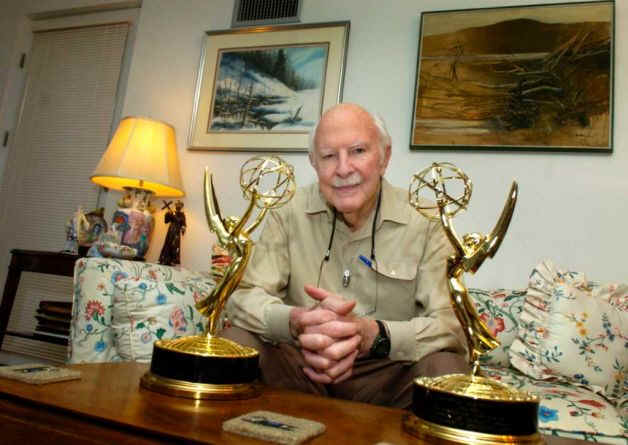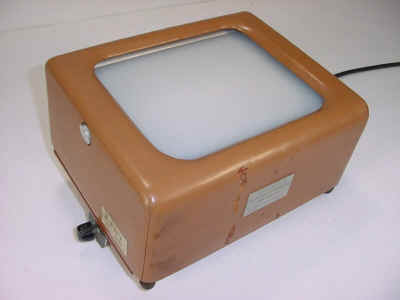Hubert
Schlafly, Teleprompter inventor and satellite visionary, dies at 91
Lisa
Chamoff, Staff Writer
Updated
10:43 pm, Friday, April 22, 2011
|

|
 |
| Former
Greenwich resident Hubert Schlafly, shown here in the Edgehill
retirement community on Palmer Hill Road in Stamford in January
2008 died April 20, 2011. Schlafly was an engineer whose
invention of the teleprompter and execution of the first
satellite transmission of a cable television programming
transformed the industry. He was 91. Photo: File Photo |
Former
Greenwich resident Hubert J. Schlafly, shown her in April 2001,
died April 20, 2011. Schlafly was a visionary engineer whose
invention of the teleprompter and execution of the first
satellite transmission of a cable television programming
transformed the industry. He was 91. Photo: File Photo |
Hubert
Schlafly, an Emmy Award-winning engineer who helped shape modern
television by inventing theteleprompter and
executing the first satellite transmission of a cable program, died Wednesday.
Schlafly,
a longtime Greenwich resident who in recent years moved to the Edgehill
retirement community in Stamford, was 91. He died at Stamford
Hospital after a
brief illness, according to close friend Thomas
Gallagher, of Riverside.
Schlafly
is perhaps best known for developing the teleprompter with Broadway
actor Fred
Barton Jr. and Irving
Berlin Kahn, nephew of the famous composer and vice president of
radio and television at 20th Century Fox.
Barton
came up with the idea for creating a device to take the place of a live
person helping actors with their lines. Kahn asked Schlafly, who served
as 20th Century Fox's director of television research and was a prolific
inventor, to build it.
"I
said it was a piece of cake," Schlafly told The Advocate of
Stamford in a 2008 interview.
The
device -- a box with a motorized scroll printed in half-inch font, with
a red arrow indicating the text to be spoken -- debuted in 1950 on a
soap opera called "The First Hundred Years." In 1952, Herbert
Hooverbecame the first politician to use a teleprompter, when he
gave the keynote address at the Republican
National Convention.
At
first, a stagehand controlled the device. Later, mirrors projected the
text in front of the camera lens, so a television actor could appear to
be looking directly at the audience.
Schlafly
also developed the first pay TV system that permitted subscribers to
order special programs to be delivered by coaxial cable. By the early
1970s, TelePrompTer Corp. owned franchises in 140 markets and served
approximately 1.4 million customers.
In
June 1973, Schlafly executed the first satellite transmission of a cable
program from Washington, D.C., to a convention of 3,000 cable operators
in Anaheim, Calif. Two years later, he engineered the famous HBO
satellite transmission of the "Thrilla in Manila" boxing match
between Muhammad
Ali and Joe
Frazier.
Among
his many awards, Schlafly received two Emmys for television technology
for his invention of the teleprompter and for his contributions to cable
television. In 2008, at age 88, Schlafly was inducted into the Cable
Television Hall of
Fame. After his acceptance speech, Schlafly revealed to the audience
that it was the first time he had ever used a teleprompter in delivering
a speech.
Gallagher
said Schlafly was a visionary and problem-solver. The U.S. didn't have a
commercial satellite in 1973, Gallagher said, and Schlafly had to track
down a commercial satellite in Canada and facilitate sending up signals.
"We
take for granted all of this technology today," Gallagher said.
Charles
Dolan , founder and
chairman of Bethpage, N.Y.-based Cablevision , said Schlafly was
"perhaps the most collaborative and authoritative leader in the
cable industry."
"He
did so much in the early years of cable to improve its technology,"
Dolan said in a statement. "He led TelePrompTer Corp. in a
difficult period and assembled a staff that has since provided
leadership for many companies."
Schlafly,
who friends called "Hub," was born on Aug. 14, 1919, in St.
Louis, Mo. He graduated from the University
of Notre Dame, where he studied electrical engineering, in 1941,
then spent several years working for General Electric and the MIT
Radiation Laboratory. He joined 20th Century Fox in New York City in 1947.
In
1975, Schlafly moved with his wife, Leona, to the Millbrook section of
Greenwich. He served as president of the Greenwich
Rotary Club and was
involved in the Millbrook
Association.
The
digital media lab at Sacred
Heart University in
Fairfield was dedicated in Schlafly's honor. As a tribute to his wife,
Schlafly underwrote the costs of the Chapel of the Nativity, the daily
worship space of the university's Chapel of the Holy Spirit, which
includes original mosaics and stained glass by Jesuit Father Marko
Rupnik.
"Hub
was a dear and very generous friend: in all matters, a gentleman," John
Petillo, Sacred Heart University's president, said in a statement.
"Everyone here owes him a debt, from his leadership support of our
communications department to the student scholarships he established to
the many lively exchanges he enjoyed with students and faculty about his
pioneering inventions and media work."
A
lifelong Catholic, Schlafly was a member of the Order of Malta and was a
Knight of St. Gregory the Great. His wife of 59 years, Leona
"Lee" Schlafly, died in 2003.
A
Mass will be held on Tuesday at 10 a.m. at Saint Mary Parish, 178
Greenwich Ave. A graveside service will take place on Thursday, in
Louisville, N.Y.

